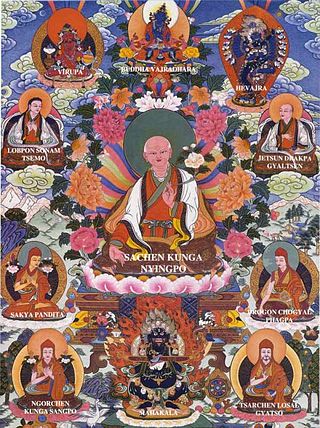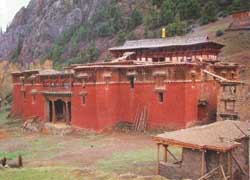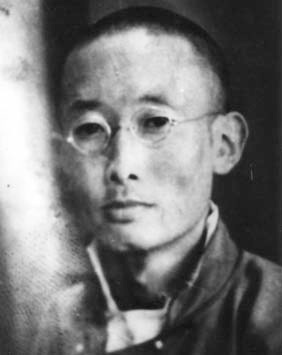
Padmasambhava, also known as Guru Rinpoche and the Lotus from Oḍḍiyāna, was a tantric Buddhist Vajra master from India who taught Vajrayana in Tibet. According to some early Tibetan sources like the Testament of Ba, he came to Tibet in the 8th century and helped construct Samye Monastery, the first Buddhist monastery in Tibet. However, little is known about the actual historical figure other than his ties to Vajrayana and Indian Buddhism.

The Sakya school is one of four major schools of Tibetan Buddhism, the others being the Nyingma, Kagyu, and Gelug. It is one of the Red Hat Orders along with the Nyingma and Kagyu.

The Kagyu school, also transliterated as Kagyü, or Kagyud, which translates to "Oral Lineage" or "Whispered Transmission" school, is one of the main schools of Tibetan Buddhism. The Kagyu lineages trace themselves back to the 11th century Indian Mahasiddhas Naropa, Maitripa and the yogini Niguma, via their student Marpa Lotsawa (1012–1097), who brought their teachings to Tibet. Marpa's student Milarepa was also an influential poet and teacher.

Atiśa Dīpankara Śrījñāna was a Buddhist religious leader and master. He is generally associated with his work carried out at the Vikramashila monastery in Bihar. He was one of the major figures in the spread of 11th-century Mahayana and Vajrayana Buddhism in Asia and inspired Buddhist thought from Tibet to Sumatra. He is recognised as one of the greatest figures of medieval Buddhism. Atiśa's chief disciple, Dromtön, was the founder of the Kadam school, one of the New Translation schools of Tibetan Buddhism, later supplanted by the Gelug tradition in the 14th century which adopted its teachings and absorbed its monasteries.

Jamyang Khyentse Wangpo, also known by his tertön title, Pema Ösel Dongak Lingpa, was a renowned teacher, scholar and tertön of 19th-century Tibet. He was a leading figure in the Rimé movement.

Patrul Rinpoche (1808–1887) was a teacher and author from the Nyingma school of Tibetan Buddhism.

gZhon-nu-dpal (1392-1481), also known as 'Gos Lo-tsa-ba was a famous Tibetan historian and scholar, known as the author of the "Blue Annals".
Rongzom Chökyi Zangpo, widely known as Rongzom Mahapandita, Rongzom Dharmabhadra, or simply as Rongzompa, was one of the most important scholars of the Nyingma school of Tibetan Buddhism. Together with Longchenpa and Ju Mipham, he is often considered to be one of the three "omniscient" writers of the school. His elder contemporary Atiśa (980–1054) considered Rongzompa to be an incarnation of the Indian ācārya Kṛṣṇapāda, the Great. The Tibetan historian Gö Lotsawa (1392–1481) said of Rongzom that no scholar in Tibet was his equal.

Trülku Drakpa Gyeltsen (1619–1656) was an important Gelugpa lama and a contemporary of the 5th Dalai Lama (1617–1682). His Seat was the upper residence of Drepung Monastery, a famous Gelug gompa located near Lhasa.

Karma Gon Monastery, the original monastery of the Karma Kagyu sect of Tibetan Buddhism, was founded in the 12th century by Düsum Khyenpa, the 1st Karmapa Lama in eastern Tibet at the age of 76. Karma Gon, is located on the eastern bank of the Dzachu River in Chamdo, eastern Tibet. Karma Dansa was the cradle of the karma kagyupas. When established the Karmapa had gathered 1000 monks around him here. Karma Gon was named as Karma Dansa as an administrative unit and the Chinese Ming Court enlarged the monastery’s jurisdiction by adding the Mekong’s middle and upper reaches. It was then also called Gama Dansa Si in Chinese.

Katok Monastery, also transliterated as Kathok or Kathog Monastery, was founded in 1159 and is one of the "Six Mother Monasteries" in Tibet of the Nyingma school of Tibetan Buddhism, built after Samye Monastery. It is located in Payul, Karze Prefecture, Sichuan, China, known as Kham.

Gendun Chompel or Gendün Chöphel (1903–1951) was a Tibetan scholar, thinker, writer, poet, linguist, and artist. He was born in 1903 in Shompongshe, Rebkong, Amdo. He was a creative and controversial figure and is considered by many to have been one of the most important Tibetan intellectuals of the twentieth century.

George Nicolas de Roerich was a prominent 20th century Tibetologist. His name at birth was YuriNikolaevich Rerikh. George's work encompassed many areas of Tibetan studies, but in particular he is known for his contributions to Tibetan dialectology, his monumental translation of the Blue Annals, and his 11-volume Tibetan-Russian-English dictionary.

Phagmo Drupa Dorje Gyalpo [1110-1170], was one of the three main disciples of Gampopa Sonam Rinchen who established the Dagpo Kagyu school of Tibetan Buddhism; and a disciple of Sachen Kunga Nyingpo [1092-1158] one of the founders of the Sakya school of Tibetan Buddhism. He was the elder brother of Kathog Dampa Deshek [1122-1192], who founded Kathog monastery and the Kathog branch of the Nyingma school.

Lochen Rinchen Zangpo, also known as Mahaguru, was a principal lotsawa or translator of Sanskrit Buddhist texts into Tibetan during the second diffusion of Buddhism in Tibet, variously called the New Translation School, New Mantra School or New Tantra Tradition School. He was a student of the famous Indian master, Atisha. His associates included (Locheng) Legpai Sherab. Zangpo's disciple Guge Kyithangpa Yeshepal wrote Zangpo's biography. He is said to have built over one hundred monasteries in Western Tibet, including the famous Tabo Monastery in Spiti, Himachal Pradesh, Poo in Kinnaur and Rinchenling monastery in Nepal.

Kundeling Monastery is a Tibetan Buddhist monastery in Lhasa, Tibet, China. It was founded around 1794, and follows the Gelug school. The head of the monastery belongs to a lineage of incarnations that dates back to 1402. There is dispute over the current incarnation. The monastery was destroyed during the Cultural Revolution, then rebuilt in the 1980s.
Dagpo Kagyu Tibetan: དྭགས་པོ་བཀའ་བརྒྱུད, Wylie: dwags po bka' brgyud encompasses the branches of the Kagyu school of Tibetan Buddhism that trace their lineage back through Gampopa (1079-1153), who was also known as Dagpo Lhaje "the Physician from Dagpo" and Nyamed Dakpo Rinpoche "Incomparable Precious One from Dagpo". All the institutional branches of the Kagyu tradition of Tibetan Buddhism surviving today, including the Drikung Kagyu, the Drukpa Lineage and the Karma Kagyu, are branches of the Dagpo Kagyu.
Zhang Yudrakpa Tsöndru Drakpa (1122–93) (zhang g.yu brag pa brtson 'gru brags pa), also known as Gungtang Lama Zhang(gung-thang bla-ma zhang) and often simply as Lama Zhang, was the founder of the Tshalpa Kagyu sect of Tibetan Buddhism. He was a prominent religious figure, and his extensive involvement in the political and military conflicts of Tibet was controversial at the time. Lama Zhang played a key role in the medieval Buddhist revival in Central Tibet, also called the “Tibetan renaissance”.
Geshey Gendün Rinchen, was the 69th Je Khenpo of Bhutan.

Chadrel Rinpoche, also known as his dharma name Jampa Trinley, is a Gelug lama of Tibetan Buddhism. In 1954, he joined the Tashilhunpo Monastery at the age of 15. He was a close disciple of Choekyi Gyaltsen, the 10th Panchen Lama. Later, he became the khenpo of the Tashilhunpo Monastery. Chadrel Rinpoche was instructed to lead the Chinese efforts to install a substitute 11th Panchen Lama, but he instead aided efforts to locate the authentic reincarnation, and to recognize Gedhun Choekyi Nyima in 1995. As a result, he was arrested, imprisoned, the held under house arrest until his reported death from a suspicious poisoning in 2011. He was also a Member of the 7th and 8th Chinese People's Political Consultative Conference (CPPCC).















